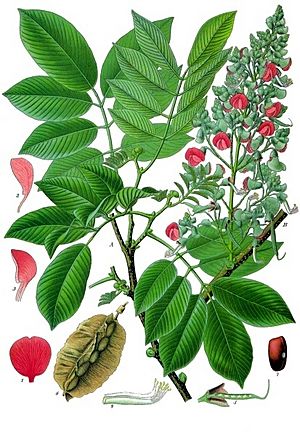Florida fishpoison tree facts for kids
Quick facts for kids Florida fishpoison tree |
|
|---|---|
 |
|
| Scientific classification | |
| Kingdom: | |
| (unranked): | |
| (unranked): | |
| (unranked): | |
| Order: | |
| Family: | |
| Genus: |
Piscidia
|
| Species: |
P. piscipula
|
| Binomial name | |
| Piscidia piscipula (L.) Sarg.
|
|
| Synonyms | |
|
Piscidia erythrina L. |
|
The Piscidia piscipula, often called the Florida fishpoison tree, Jamaican dogwood, or fishfuddle, is a medium-sized tree. It loses its leaves each year. This tropical tree grows naturally in the wider Caribbean region. You can find it in southern Florida (especially the Florida Keys), the Bahamas, many Antillean islands, and along the coast from Panama to Mexico.
Long ago, Native Americans in the West Indies found that parts of this tree could make fish sleepy. This made the fish easy to catch by hand. This is how the tree got its common names, "fishpoison" and "fishfuddle." The tree also has uses in medicine, helping with pain and as a calming agent. Its scientific name, Piscidia piscipula, means "fish killer" and "little fish" in Latin.
Contents
Where the Florida Fishpoison Tree Grows
The Florida fishpoison tree likes to grow near coastlines. It prefers sandy soil that drains well, with a layer of rich, dark earth on top. This tree can handle short floods of salty or brackish (slightly salty) water from storms. Even though it grows near the coast, other plants usually protect it from direct salt spray.
Once the tree is grown, it can handle dry weather very well. However, it cannot stand cold temperatures. This limits the Florida fishpoison tree to warm areas, like plant hardiness zone 11 or warmer.
What the Florida Fishpoison Tree Looks Like
The Florida fishpoison tree can grow to be medium-sized. It usually reaches heights of 12 to 15 meters (about 39 to 49 feet). Its main trunk can be 46 to 118 centimeters (about 1.5 to 3.9 feet) wide. It has an open, uneven crown with strong, upright branches.
Leaves, Flowers, and Pods
The tree's leaves are 9 to 23 centimeters (about 3.5 to 9 inches) long. They grow in an alternate pattern along the stem. Each leaf is made up of 5 to 11 smaller leaflets. These leaflets are dark green on top and a lighter grayish-green underneath, with soft hairs.
In May, the tree produces white flowers that have hints of red or pink. They grow in clusters, looking a bit like pea flowers, and are very attractive to bees. Trees can start blooming when they are about 4 meters (13 feet) tall and 4 years old.
After the flowers, light brown, bean-like pods grow. These pods are 8 to 10 centimeters (about 3 to 4 inches) long and have four papery wings. They ripen in July and August. Inside the pods are oval-shaped, red-brown seeds.
Bark and Growth
The bark of the Florida fishpoison tree is thin and olive gray. It has dark, uneven patches and many small scales. The bark has an unpleasant smell and a very sharp, bitter taste. It can cause a burning feeling in the mouth.
After being taken from the ripe pod, the seeds will sprout in 8 to 10 days if planted about 6 millimeters (0.2 inches) deep in moist soil. Young plants need to be fertilized and watered until they are strong. New trees can also grow easily from cuttings placed in moist soil. Sometimes, even fence posts made from fresh wood will accidentally start to grow roots!
Wildlife and the Florida Fishpoison Tree
The Florida fishpoison tree is an important plant for several types of butterfly larvae (caterpillars). These include the native cassius blue butterfly (Leptotes cassius) and the hammock skipper (Polygonus leo). It is also a host plant for the introduced fulvous hairstreak (Electrostrymon angelia).
How People Use the Florida Fishpoison Tree
Growing the Tree
In places with the right climate and soil, the Florida fishpoison tree makes a strong, medium-sized shade tree. It has pretty seasonal flowers. It is great for yards and along fence lines. This tree needs full sunlight to grow its best.
Using the Wood
The wood of the fishpoison tree is yellow-brown and resists decay. This makes it good for outdoor uses, like building boats, making fence posts, and poles. The wood is dense and has a tight grain. It is also used as fuel, to make charcoal, and is good for carving.
Traditional Fishing Methods
Many native peoples around the world used plants with natural poisons to help them catch fish. This is why many such plants have names that describe this use. In its natural habitat, Native Americans used a liquid extract from the bark, roots, twigs, and leaves of the Florida fishpoison tree. This extract would make fish sleepy, making them easier to catch. The tree contains several chemicals that are toxic to fish, with the main one being rotenone.
Herbal Medicine Uses
P. piscipula can be toxic, so it should only be used under the guidance of a doctor. The correct amount to use must be decided for each person. It has been used in herbal medicine to help with nervous conditions and pain. Recent scientific studies on animals suggest that extracts from the bark might help with anti-inflammatory (reducing swelling), sedative (calming), and antispasmodic (reducing muscle spasms) effects.
See also
 In Spanish: Barbasco para niños
In Spanish: Barbasco para niños

